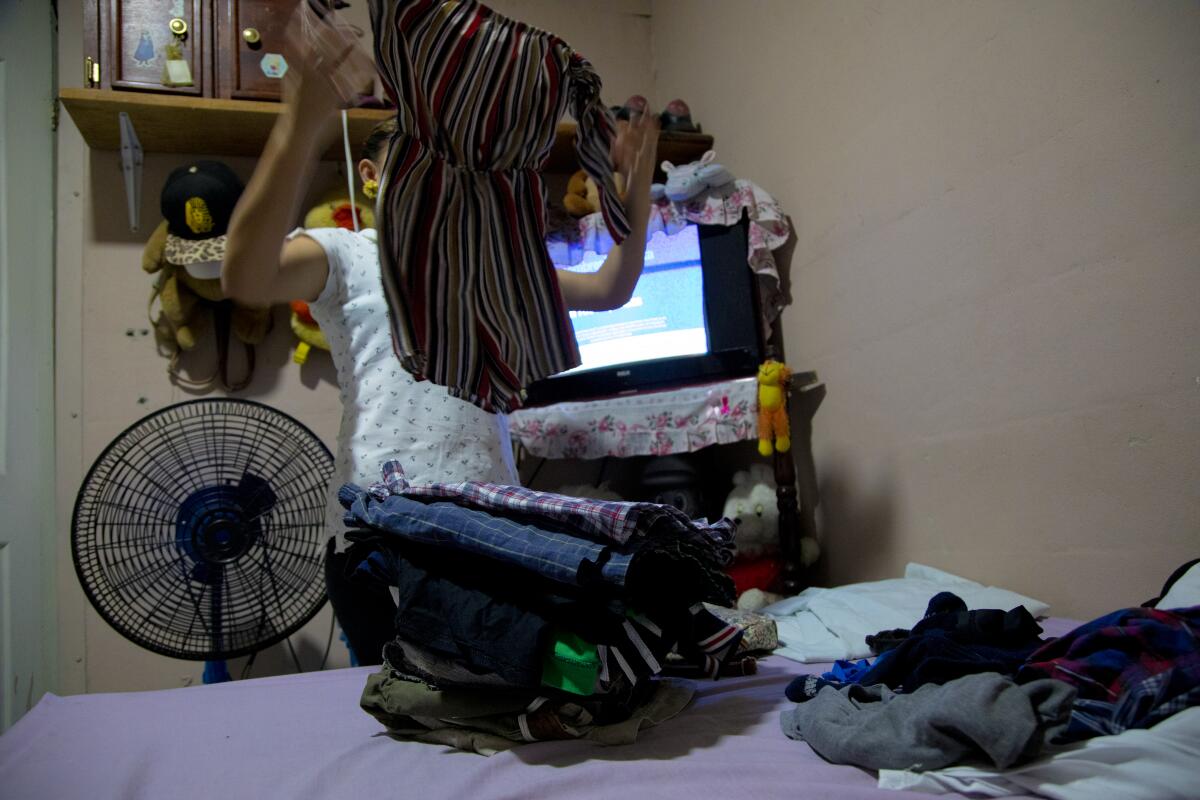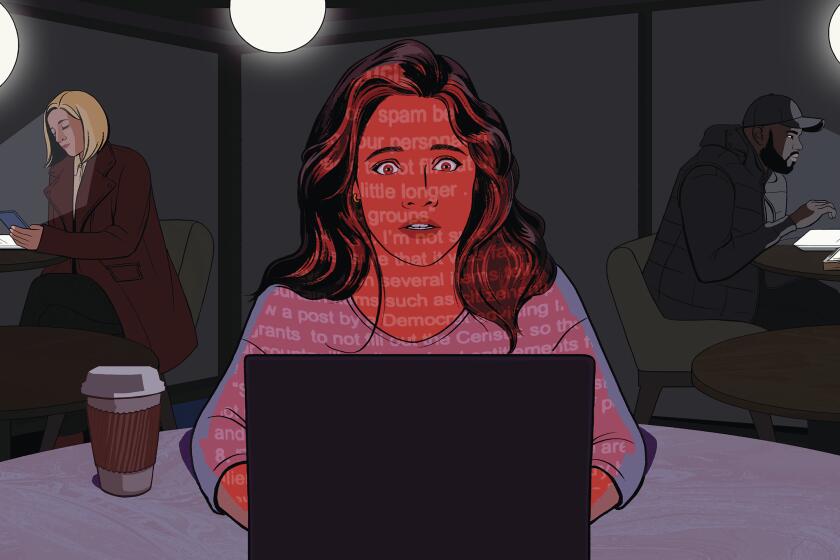Dads are doing less at home again, fearing a career hit

- Share via
When the pandemic disrupted everything, it also thrust fathers into the home like never before. It was a moment that looked like it could bring some relief to working moms. Dads had the flexibility — and the desire — to take on more responsibility. Then, the world got in the way.
Back in 2020, while Lindsey Jackson and her husband, Clarence, were both stuck working from home, they were splitting household chores and child care for their 2-year-old son just about evenly. But now that Clarence, a financial advisor at JPMorgan Chase & Co., is going back to the office and Lindsey isn’t, things are shifting to mean Lindsey is taking on more. She’s so busy she has to cook and bathe her son at the same time.
“It’s just much more responsibility on her for caring for him,” Clarence said.
The pandemic, over time, has worsened some gender inequalities in American homes. Both moms and dads spent more time looking after their kids as schools went virtual and day-care centers shut down. But mothers bore the brunt of that. In 2020, women devoted 2.9 hours more per day than men to child care, compared with 2.55 in 2019, Bureau of Labor Statistics data compiled by Bloomberg News show. The disproportionate burden on mothers ends up eating into their earnings.
“We’re reverting back into our traditional gender norms,” said Misty Heggeness, principal economist at the Census Bureau. “It’s women, particularly mothers, who are still bearing the heavy lift disproportionately.”
A $100,000 signing bonus for a veterinarian? COVID has changed American work life, with employees asking for more, and employers obliging.
A child-care crisis has driven a workforce gender gap for decades, but the pandemic took things to another level, costing women globally at least $800 billion in lost income in 2020, according to Oxfam. In the U.S., roughly 20% of the 7.1 million women ages 25 to 54 who left the labor force during the onset of the pandemic-induced recession haven’t returned to work as moms struggle to find affordable care. Meanwhile, industries that employ a large number of women — education, healthcare and food — are seeing some of the worst effects of the current labor shortages.
The twist here is that being thrust into the home made many dads more willing to take on added responsibilities, which could go a long way in helping to close the gender pay gap.
For the Jackson family, when Clarence started working remotely, it made “homemaking chores more obvious,” pushing the couple closer to a 50-50 split, Lindsey said.
“It makes the work you’re doing more visible — both in work you’re getting paid for, and the work you’re doing outside of that,” Lindsey said. “It makes it harder to justify not being equal.”
As the world opened back up, dads ran into bigger problems than their own willingness to pitch in.
Researchers who’ve been studying parental roles during the pandemic say men were much more likely than women to worry that their careers would be hit by devoting more time to home duties. They felt more pressure to get away with what they could, rather than be upfront about their needs with employers.
Many workplaces are reinforcing those ideas by doing things such as offering more parental leave to new moms or giving them an easier time negotiating flexible schedules. Women, because they often work in lower-paying roles, are also more likely to leave their jobs to take on child care when there’s no other affordable option.
The trampoline park industry — once among the fastest-growing franchise businesses in America — can trace its roots to an injury-addled 1960s craze and an extreme sport you’ve never heard of.
Congressional Democrats have tussled over including paid family leave in their economic agenda, whittling the Biden administration’s original proposal of 12 weeks down to four. The U.S. is one of only seven nations that doesn’t provide paid maternity leave.
There are also cultural norms that come into play, including traditional notions of men being the “breadwinners” of the family, said Jamie Ladge, an associate professor of management and organizational development at Northeastern University who studies work-life integration. Unspoken workplace rules discourage fathers from taking full advantage of paternity leave when it’s offered, with more than two-thirds of dads saying they’ve felt the pressure to return from leave as soon as possible, according to a survey from Volvo Car USA and the Harris Poll.
In the early days of the pandemic, fathers and mothers were equally likely to be unemployed or on leave. But since March of this year, moms have disproportionately stayed out of the labor force, according to research published by the Federal Reserve Bank of Minneapolis.
And for the moms who’ve managed to stay employed, they don’t feel as ready to go back to offices. Almost 40% of working fathers are back in the workplace after being remote, compared with 30% of mothers, according to a survey conducted by Censuswide on behalf of LinkedIn.
Some dads, though, are fighting back.
Nineteen percent of working fathers have looked for a new job in which they can be remote, and 10% have quit or considered quitting, according to the Censuswide survey.
With U.S. employers struggling to hire in recent months, and as job openings remain near a record high of 11 million, employees’ negotiating power may increase. Plus, flexible and remote work have become much less stigmatized in a number of industries, which could make asking for those arrangements easier.
“The mind-set used to be: It’s OK for dads to take advantage of some of these supports — but don’t take it too far,” Ladge said. “But now I think it wouldn’t look weird if a dad requested some flexible work arrangement or was working from home one or two days a week. It would be normal.”
Facebook has long emphasized the strength of its efforts to contain misinformation targeted at Latinos and Spanish speakers. A whistleblower’s leaks show employees raising alarms about the problem.
Mark Eggleston lives in Wilmington, Del., and spent 17 years at a job in Philadelphia that involved an hourlong commute in each direction. When he started working from home in 2020, he was for the first time able to do more things like go to sporting events and appointments with his three children, who are 20, 16 and 14 years old.
“Suddenly, a lunch break could become a time to sit down with my daughter and have a good conversation,” Eggleston said.
So rather than go back to long-haul commuting, he quit his job in June and took a new one that’s closer to home and also gives him a more flexible work arrangement.
“Having a 15-minute commute versus an hour — I was scheduled to go to my daughter’s field hockey game Monday at 4; I couldn’t have done that a few years ago working in Philadelphia,” Eggleston said. “The norms here are the biggest thing. Giving yourself the freedom that, hey, this is something normal to do — that helps other people do it.”
Reade Pickert of Bloomberg contributed to this report.
More to Read
Inside the business of entertainment
The Wide Shot brings you news, analysis and insights on everything from streaming wars to production — and what it all means for the future.
You may occasionally receive promotional content from the Los Angeles Times.












